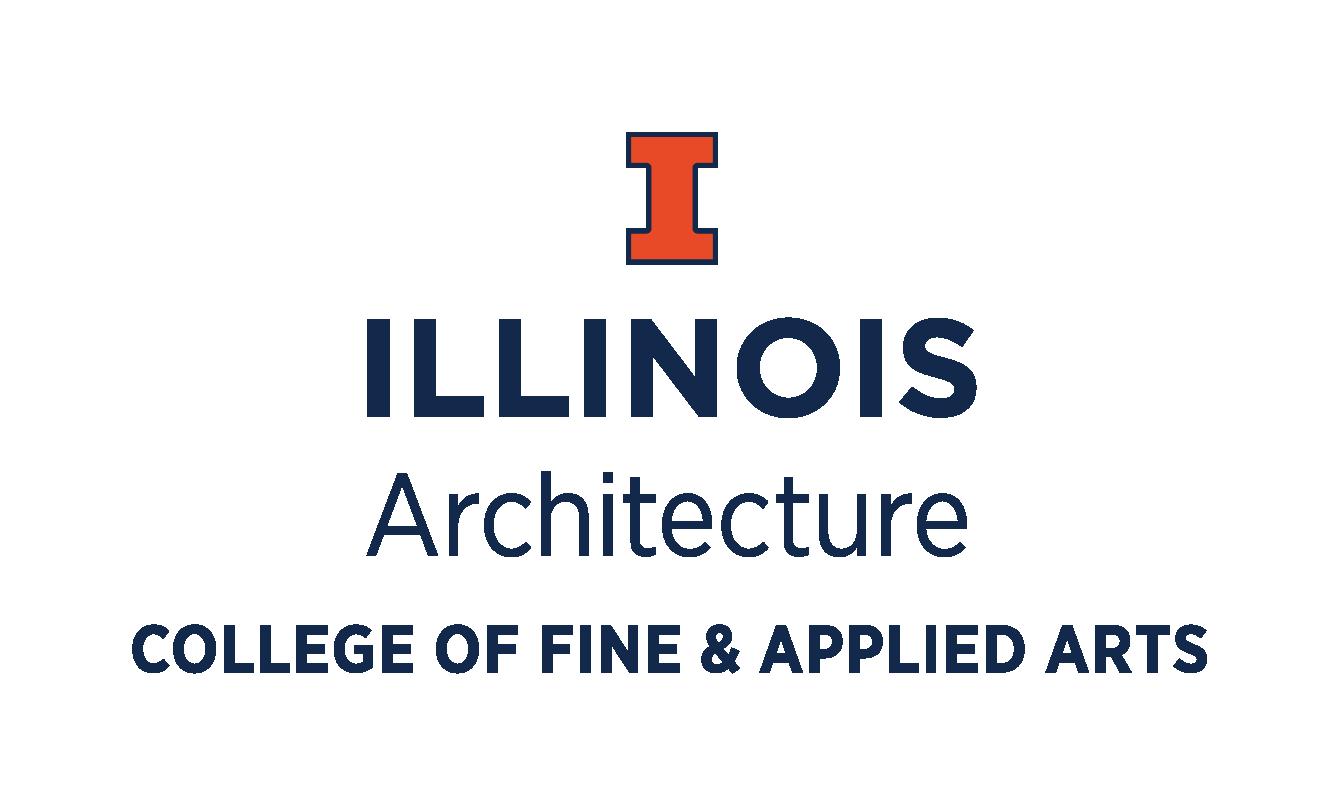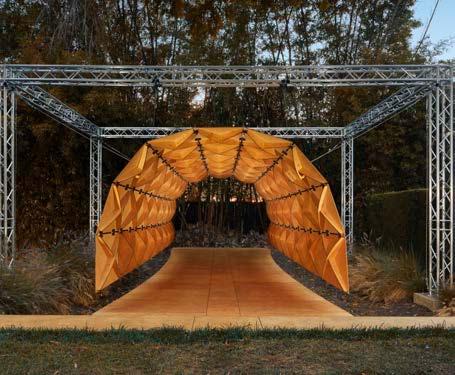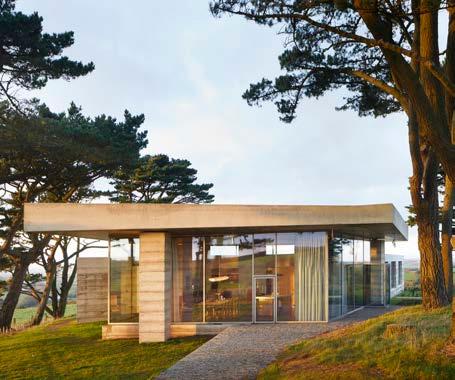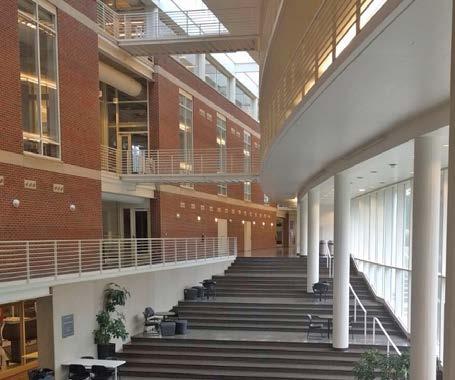Q&A
Q: What is your favorite place you have traveled to, and why?
A: Colombia because it is a country of amazing people, cities and rich cultural traditions that are well depicted in the tales of Gabriel Garcia Marquez, a Nobel Prize winning author of magical realism. The historic buildings possess a certain charm because they were handcrafted with earth and brick. Stunning landscapes can be found throughout this lush territory that is host to the Andes Mountain Range and is surrounded by oceans and rivers (the Pacific Ocean to the west, the Caribbean Coast to the north and the Amazon River passes the southern tip). The ecological diversity present in this part of the world is unparalleled!
Q: Which architect most influences your work and/ or your work habits?
A: Enric Miralles and Carlos Scarpa
Q: What skill has served you best in your architectural career?
A: Drawing and rendering have served a great deal in the design process and as a way to communicate design intent. These skills opened doors and helped attract clients. However, running a firm has required a different skillset and I am now more focused on leadership, which has been important to grow as an architect.
Q: What is your favorite previous project, and what did you do to make it a success?
A: Our office has worked on a number projects in North and South America. My favorite projects are the pro-bono challenges that we have co-designed in Colombia. We have had the fortune of collaborating on several projects with inhabitants of communities that have been plagued with violence over the past several decades. They have expressed a sincere desire to transform their neighborhood environments and it is rewarding to aid them in the enrichment of the built environment and observe the impact that this can have.
Q: In your opinion, what has been the most rewarding part of teaching students at the college level?
A: I have taught at universities in two countries, each with very distinct economic, social, ecological and political conditions. It is always enjoyable to work with talented and passionate students who are deeply committed to the development of their critical thinking and design skills. The work we do in the Detail + Fabrication Program Area pushes students to build things that are tested at the 1:1 scale. This provides unique opportunities to grow as an architect and designer and it is very rewarding when students confront numerous challenges and are able to design, fabricate, exhibit and see how people inhabit their creations. One recent example of a project realized in a studio I taught are the screen structures that were designed, developed and fabricated for the local municipality. It was fantastic to install a structure downtown Urbana and be standing with Brad and Nico as the Mayor of Urbana inaugurated the park last week. Furthermore, it is gratifying to see students graduate and apply their skills in praxis where they make positive impacts on the built environment. It is only my third year at ISoA and it has been satisfying to hear about the exciting work my former students are already doing just a year out of school!
Q: Where do you see yourself 5 years from now? 20?
A: I see myself continuing to work on design research projects that are able to leverage the knowledge and expertise and advanced technologies found in academia with the needs of impoverished communities outside of the university campus. For the next 5 years, I will continue to research and work on developing design solutions for post-conflict zones. My focus will be on building bridges with Hispanic communities in North and South America. In 20 years, I hope to expand to other areas of the world and increase the scope of the interventions.
09
Karl Daubmann
~
Visiting Lecturer | Professional Dean + Professor | LTU College of Architecture and Design
Karl Daubmann Lawrence Technological University Dean + Professor College of Architecture and Design
With over 30 years of CAD / CAM experience, Karl Daubmann holds a Bachelor of Architecture from Roger Williams University and a Master of Science in Architectural Studies from Massachusetts Institute of Technology (MIT).
He is currently the Dean and Professor at the College of Architecture and Design at Lawrence Technological University. He teaches and focuses in digital media, robotic fabrication, construction, and multidisciplinary design.
He is also a fellow of the American Academy in Rome and won a Prize in 2015 to research in Rome. His research was focused on construction geometry related to Baroque design and architecture. This was also the subject of his inspiring and intriguing lecture in Plym Auditorium in September.

As a registered architect, Daubmann focuses his projects based on his interests in design technology, manufacturing, and multidisciplinary design, much like his academic focuses for LTU.

11
Q&A
Q: What brought you into the field of architecture?
A: I actually really wanted to design cars originally. Although, on my college visits, I was going to see the school of architecture and while seeing the studios and the creative spaces, I changed my mind last minute and applied to architecture programs.
Q: What continued your path from academic studies in architecture to where you are today at LTU focusing on digital media, robotic fabrication, construction, and multidisciplinary design?
A:There is a generation of us, who are speculating on the fact that we were trained in an analogue way in our undergraduate studies. When we went to graduate school it was all becoming digital. So we are relatively split between those two factors.
Continuing on my path, we begin to talk about: should we even be teaching drawings these days? Or has BIM (building informational modeling) completely surpassed the notion of drawings and sketching floor plans, sections and elevations. Now, when you create a comprehensive model, digitally, it is simply an outcome of your digital/BIM representation. I think there are a lot of innovative and interesting things happening in that.
Q: In the world of academia, is there an area where you think the industry should be heading?
A: I think there are a lot of different places, and a lot of different schools approaching things in different ways. For me, I’d always imagined it as practice would come to academia and say: ‘what is the next thing, where are we heading?’. And it feels like, in recent years, practice has outpaced higher education because technology is changing at an exponential rate.
One of the things LTU does differently is we have a masters degree option online. People often get confused with the idea of it, because most professionals in the world today did not have the option to take studio online. However, [architects and engineers] are all collaborating that way now. They are collaborating with consultants in another state or working on a project in another country with clients from other countries. We share files on the cloud, we
skype, and we begin to think: ‘can we also teach this way?’. For us, it is a technological approach, especially as a technological university. I begin to think of it less as a college, and more as a technology company that teaches classes. This makes you question and consider how to teach data and technology in the modern world.
Q: What do you see the industry as ten years from now?
A: I think our investment now, is in technology, as we have already discussed. How do we orient ourselves in new and different ways. Design, from a perspective, is somewhat separated from the making of a ‘thing’. As designers, whatever it may be, there is an intermediary step between design and making, which might or might not remain several years in the future. I think whether it remains will be quite interesting. Some of it is thinking about communication and how you might use a robot to make ideas clear and share intent.
If you could share information to a robot, you should be able to convey that same information to a client or to a company. However, how we share that data and information is currently very different.
Q: What are your thoughts on the changing half-life of information technology? Do you advocate for a more entrepreneurial approach (along with the innovations in technology) with students at LTU?
A: Yes, in fact we are teaching students this semester a leadership class for undergraduates. My belief is that architects have been, either explicitly or implicitly, told not to think about money or business. And I think it has really hurt our profession. From an undergraduate perspective, we are trying to suggest a more wellrounded approach, so that if someone wants to take a more business-oriented approach, you could find ways to own your own firm and pay your workers more. Whether it is different types of investments, different types of revenue streams, or different types of organizational structures, it is still all under the umbrella of design. And this design is what comes under the college I am the Dean for. The data and the design all can be taught as well, and prove beneficial, especially if you could pay your workers better as well.
Pictures (right): Chicago Southside | Building Inertia
12


13
A Vision for the School of Architecture, or What We Talk About When We Talk About That Cafe
By Randy Deutsch AIA, LEED AP
~
My vision for the School of Architecture is for it to remain exactly as it is, only with a café.
So, let’s talk about this café.
It is as nice a café as any you have entered. The décor is tasteful, unobtrusive and welcoming; the foods, beverages, and service are – while unranked – always stellar. A special place, the café remains outside its locale a well-kept treasure.
The café’s style is ambiguous enough that everybody can read what he or she wants into it. Something about the café feels familiar to everyone.
No matter what part of the world a student has travelled from, they seem to recognize the café and it’s traditional foods and condiments. En masse they text their parents that they feel immediately and entirely at home here.
The café, located in north central atrium, has tables and chairs, and the open air seating arrangement encourages engagement and interaction. Despite its near constant laughter and buzz, the café is calm, quiet and spacious.
All times crowded, you nevertheless always seem to be able to find a seat. There is always someone there who is happy to see you and asks you to join their table. There is always a place for you at the café.
The café offers a diverse, interdisciplinary and rigorous menu served by an accomplished waitstaff. The café serves healthy snacks, street foods, innovative and indulgent desserts, and, depending on the going market rate and student budgets, Intelligentsia or La Colombe coffee. The coconut creamer never runs out.
In the café, students meet – with each other, with
professors, with staff – as well as with the students, professors, and staff from architecture’s sister schools, urban planning and landscape, as well as with folks from other units within the college, and beyond.

So student-centric, revered, and enjoyed by the locals that students from BIF are said to frequent the café in off-hours, for its legendary snacks, and to study the heavily drawn- and jotted-upon paper tablecloths that have been left behind, picking-up a thing or two about design-thinking along with their caffeine.
What’s notable about the café are these paper tablecloths. Each table comes with a set of markers that students use to plan, scheme, and strategize their next moves, whether architectural, existential, professional, social, or geographic.
In addition to talking, students in the café are always writing or designing, often both, and when they get up to leave, they take their ink-covered paper tablecloth with them, exposing a fresh, blank one underneath, for the next tablemates to inscribe with their schemes, plans and dreams.
Thirty years after attending the School, graduates who have been known to misplace their diplomas, car keys or wallets know exactly where their paper tablecloths from their school days are, as these talismans and Codex contain their career DNA. Like a pirate’s treasure map, these paper artifacts have inscribed in them instant direction, vision, renewed spirit and purpose on their quests beyond the School.
It is on these paper tablecloths that students envision their futures. Perhaps unbeknownst to them at the time, it’s their sketching, writing and talking-over the paper tablecloths that prepare students for the challenges they face in the profession—and the world—beyond the cafe.
15
Their ever-changing tablemates and inconspicuous servers help students to get where they need to go, showing them the ropes and resources, connecting them with opportunities. The café seems to say: Come for the coffee, stay to discuss your ambitions, and leave to discover your destiny!
With little fanfare or flair the café has come to espouse all that the School stands for: the café menu and social buzz is the epitome of health and well-being; the café’s unobtrusive data-capture improves the performance of the building where the café resides; the detail+fabrication-produced café furniture are ergonomically designed, with nearby hammocks and nap pods for the sleep-deprived; the café’s street food cred and third-place charm are hallmarks of urbanism; and behind the counter, the alumni-donated Bezzera espresso machine from the 1906 Milan Fair, adds the perfect touch of history and preservation. All who frequent the café live the very ideals that the School professes.
While the distinct and joyous sounds of the kora or West African harp, steel drum, sitar and didgeridoo play lightly in the background, only those present in the café can hear the mystical, timeless, life-giving, nurturing, and ancient melodies.
The laughter is so constant, the conversations are so insightful, intelligent, and interesting, and students are so engaged in their tablecloth drawing, that they forget to look at, or even take out, their phones. Over time, students altogether stop taking their phones to the café.
The café is the only place in the School where one can neither see nor hear the atrium’s blow-your-mind large screen display, redolent of Guy de Maupassant’s observation how the restaurant in the Eiffel Tower is the one place in Paris where one cannot see the Eiffel Tower.
Since its opening, 10,000 School of Architecture graduates – from firm leaders to deans of schools, from exceptional job candidates that everybody seeks to architects-in-the-making who put people first – have patronized the café.
Neither too simple nor too complex, too hot nor too cold, embedded in the heart of the heartland, the café is just right. It’s a place where students dream of being whoever they want to be, a safe place to try out different designs, roles, costumes, customs, ideas, ideals, turns-of-phrases, and bon mots.

16
The café is at once urban, yet a place away from the pressures of a big city. The café is a place where any pressure is decidedly off. A place where students have room to stretch, to experiment, to become who they want to become, who they believe they are meant to be. To try on for size whomever their family, friends or professors believe they already are, or could soon become, but cannot themselves see or, for whatever reason, believe.
The café is a place to explore, to critically engage the complexities of society and the natural environment. In the café, students are encouraged to develop their own voice. Spacious, there’s room to move, to grow, room for ideas to grow and blossom. Where students, with the assistance of waitstaff and others, come into their own as future design professionals or whatever it is that is awaiting them beyond the confines of the café.
Significantly, this is the first time in the School’s history that the café has been patronized almost entirely with the current cohort. As future stewards of our built and natural environment, they are loyal, hard working – willing to put in the time and work, paying their dues now for a future pay-off (they all passed the marshmallow test) – who are wired to care, who want to do meaningful work, and are who are hopeful of the future: in other words, dream café patrons. The café recognizes this and rewards them for their inspiration and patronage.
In the café, design becomes not only the fundamental means for actively, creatively and critically engaging the issues of the world, but its currency (though tips are of course welcome.)
The overarching vision for the School of Architecture café is to prepare our graduates to come into their own, then once ready to leave, to become all they are capable of becoming. They are always welcome to return to the café, whether for sustenance or nourishment or just to say hello, give something back, and be off again.
In my vision for the School of Architecture I would wish for it to remain exactly as it is, only with this café.
In this post Associate Director for Graduate Studies and Clinical Associate Professor Randy Deutsch shared his vision for the School of Architecture.

17
~
Moshe “Maury” Lipowich Distinguished Alumni University of Illinois Architecture 1956
Maury Lipowich: Road to Architecture

Maury Lipowich was born in Poland and was one of the 1,200 Yaldai Tehran (Children of Tehran), a group of orphans brought to Palestine by way of Tehran during World War II. He was raised in Kfar Hanoar Hadati, a children’s village in Israel. After serving in the Israeli army as a sergeant major, he came to the United States in 1956.

He earned a degree in architecture from the University of Illinois at Urbana-Champaign. Continuing his pursuit of being an architect and designer of the built environment, he worked with two architecture firms, Minoru Yamasaki Associates, Inc., and Harry Weese & Assoc., before founding Maury M. Lipowich and Assoc., an architecture firm in Chicago.
He continued his practice, designing office buildings, temples, schools, banks and custom residences. He later founded Birchwood Development Corporation and designed and built over 50 homes on Chicago’s North Shore before retiring to Arizona.
Additionally, he was known for creating walking sticks, menorahs and sculptures out of dried saguaro cactus. He also designed windmills from recyclables with elaborate multi-layered movable elements.
19
With a passion to use materials and the built environment to its fullest extent, some of his menorah designs were made from wood or cactus. To see his passion in fabrication and materiality collide with his passion for Israel and Jewish causes only speaks more about Maury’s strong and caring character.
Additional work he has taken part in, or competed in, included: Harvard Behavioral Sciences Building (Architectural Record, July 1961), Art Center Building in Tel Aviv (Arts & Architecture, January 1964), The New Elgin National Bank (Free Press, March 1965), Kaufman’s Store (Modern Stores and Offices, March 1971), Skyview Condominiums (Dodge Construction News, January 1973), and more.
Regarding some of his design work, above, is a model for the Japanese Cultural Center Hotel, originally supposed to be in Chicago. Below, is a house he designed that resides in the suburbs of Chicago, Illinois. He has also designed a plethora of houses in Deerfield, IL.
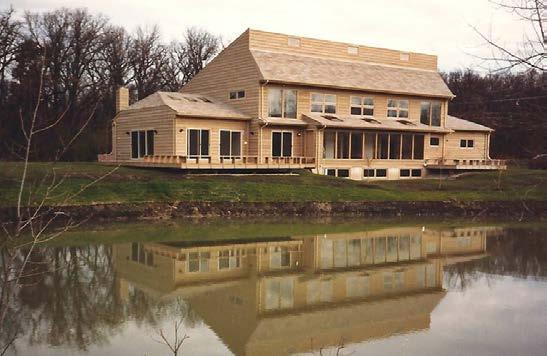
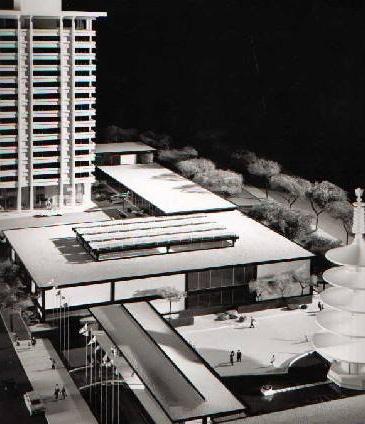
Maury Lipowich: A Caring Architect
Maury, while fluent in Hebrew, had written a periodical called: One Day in Pultusk. He wrote it in 1993, while revisiting the town in Poland in which he was born.
In its english translation, he talks about the hardships of growing up in a town being invaded by German soldiers. Being one of the 1,200 Yaldai Tehran, Maury had to endure a long journey, that for some began as early as late 1939, when (his home country) Poland was invaded.
Eventually, in February of 1943, 861 children arrived at Atlit. The children were distributed to kibbutzim and put up for adoption.
Having gone through such hardships, it is apparent why Maury had such careful relation to the sides of nature and the environment that allowed peace and a sense of serenity.
For example, at his home in Tucson, Arizona, he built a “rain room” primarily to provide a place to grow ornamentals and vegetables safe from local birds, rabbits, squirrels, etc. Both the adjacent living room and master suite/bedroom open directly to the 15 by 30-foot screened “rain room” through large glass sliders.
On cooler days, with wind and a colder breeze, the large glass doors can be opened for air to move in and through the open house. And when the doors are closed during the rain, the sound of the trickling water soothes anyone resting in the room.
It is remarkably intriguing to think about the process Maury had gone through to realize moments such as his personal “rain room”. Through his experiences, he utilized his knowledge of design in all facets of his life.
20
It is people like Maury, that are vital to the foundation of architects and architecture in the world. There is no meaning and purpose to architecture without effort, understanding, and composure of the built environment.

Sadly, “Maury” Lipowich passed away this past year. His legacy, which included passion and care for the lives of others and his profession, and beautiful intricate designs, will all live on and inspire those at the Illinois School of Architecture and in the world of architecture and design.


21
Sketches, Photography, and Design
Alumni, Professional, and Student Artwork
By Stephen Nelson, Larson & Darby Group
~
23
Stephen M. Nelson, A.I.A., LEED-AP, is an Architect working in Rockford, Illinois for Larson & Darby Group. He grew up in Bloomington, Illinois and graduated from UIUC with a B.S.A.S in 1989.

His past work experience includes Merkle Construction, Nelson Associates, Cordogan Clark & Associates, BluePoint Alert Solutions, Legat Architects, StudiGC Architecture + BIM, and Larson & Darby Group. He currently holds the position of Director of Educational Architecture and a Senior Project Manager. Larson & Darby Group is a full-service architecture, engineering, interiors and technology design firm located in Rockford, Illinois.
Some of their work, that Steve has worked on, includes: Central Community School District 301, La Moille CUSD 303, Utica Public Libray, and many other projects.
In addition to his architectural practice, Steve is an incredibly talented artist who has traveled to a plethora of different countries photographing and sketching his surroundings.
Some of the sketches in this issue include: Rheinfels Castle Ruins - Germany, Our Lady of Guadalupe - Mexico, Advocates Close –Scotland, Tower of London – England, and Main Town Square – Norway.
24
25
26
27
28
29

30


31

